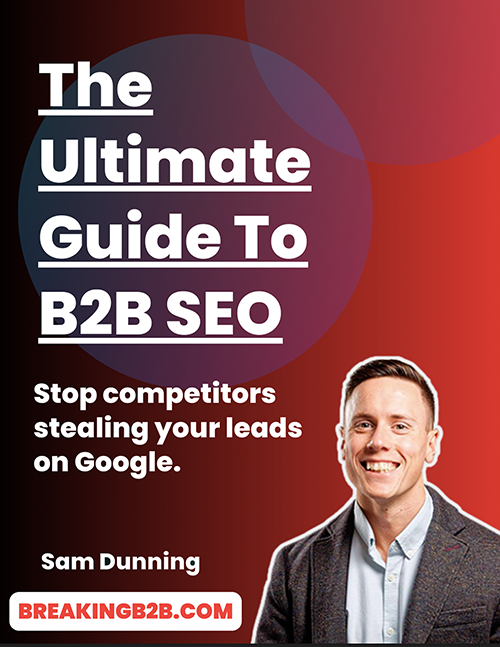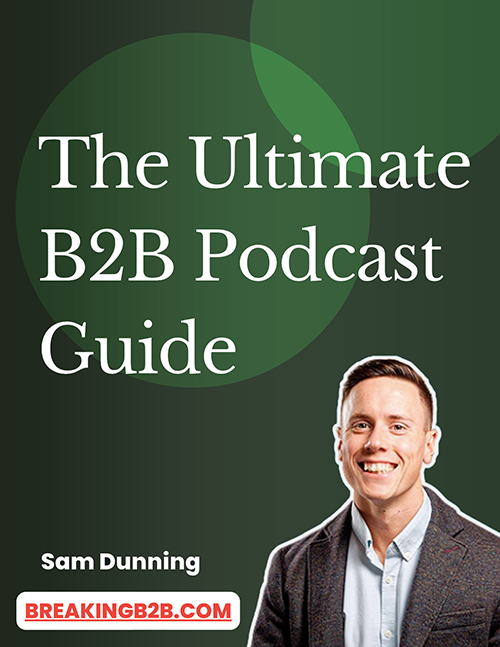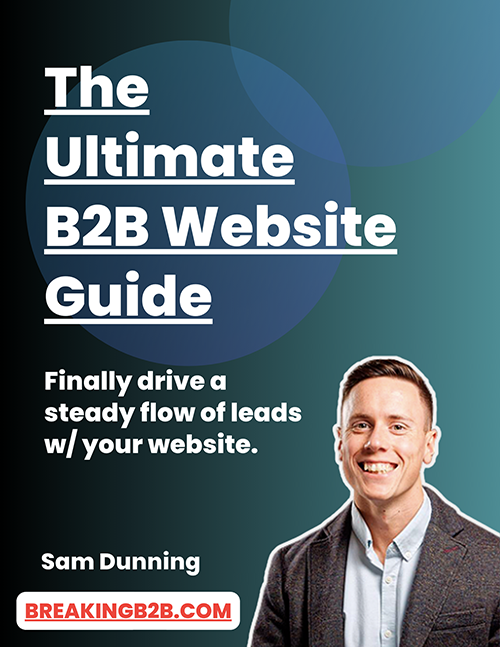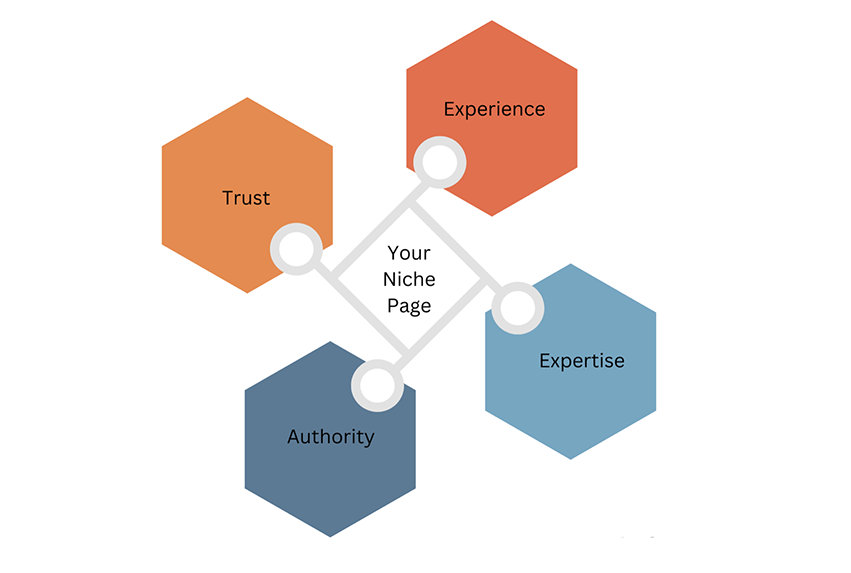Ultimate B2B SaaS SEO Guide
Want to excel in B2B SaaS SEO?
Don't worry, I've got you covered with my ultimate B2B SaaS SEO guide! - Learn how to boost revenue for your Software as a Service company using organic search, also known as SEO.
The ultimate B2B SaaS SEO guide will help you generate more leads and demo requests consistently. Prefer your B2B SaaS SEO guide in video or audio format? No problem! Tune in on Apple, Spotify, or YouTube.
And guess what? Even if you're a B2B company outside of the SaaS realm, my B2B SaaS SEO guide will still supercharge your SEO game!
Oh, and if you want to know what the most critical SaaS SEO metrics are that you should be tracking – Checkout my guide on the top 16 >HERE!<
Author: Sam Dunning ✪ Date: March 25th 2024
Problems I often spot with SaaS companies
Many focus heavily on ads and outbound sales, neglecting organic SEO.
This results in missing out on significant market demand and Google opportunities. SaaS websites tend to lack content, often limited to a few pages.
Some SaaS companies underestimate the importance of SEO, pressured by investors to meet revenue goals quickly.
Why invest in B2B SaaS SEO?
Investing in SEO allows you to create a sustainable online presence that continues to drive organic traffic and leads over time.
By implementing a robust SEO strategy, you can establish a strong foundation of evergreen content that ranks on Google, ensuring visibility for your business now and in the future.
This proactive approach not only attracts inbound leads while you sleep but also reduces the need for costly advertising as your organic traffic and leads grow steadily.
What do I need before investing in SEO?
Ensure you have a solid website that attracts, builds trust, and converts ideal clients. Your website should work seamlessly on mobile and PC, engaging prospects with design and messaging that resonate with their problems and goals.
For more tips, check out my b2b marketing podcast
Not sure if B2B SaaS SEO is a good fit?
SEO is crucial for SaaS companies to increase visibility, attract quality leads, and boost organic traffic. It's not just about ranking higher; it's an investment in your brand's future success. Unless you're in a fairly new sector/category or a niche market that nobody knows about, SEO is a smart move that pays off in long-term growth and revenue.
Keyword research
It's time to shift focus from just relying on traditional keyword research tools and software. Leveraging insights from your ideal clients and prospects directly will allow you to identify the right search terms and create relevant content. Here are some steps to follow:
- Engage with your ideal clients and prospects to understand their most common questions, objections, and problems related to your product or service.
- Gather insights on the actual words and phrases they use to describe your solution instead of relying on guesswork.
- Collaborate with your sales team to compile a comprehensive list of the questions, problems, and objections that are frequently raised.
- Use tools like Gong or similar platforms to listen to sales calls and uncover valuable insights or "hidden gems" that customers often seek answers to.
By tapping into the collective knowledge of your sales team and directly engaging with your target audience, you can enhance your keyword research strategy. This way, you can create more targeted and impactful content.
More traditional keyword research
Once you've compiled a detailed list, turn to traditional keyword research - a valuable resource for uncovering long-tail keywords and crafting content (including FAQs that resonate with your potential customers).
Kickstart your research with high-intent searches related to your offerings. For example, if you specialise in sales team software, target keywords like ‘proposal software,' ‘sales recording tools,' and ‘buyer enablement software.'
The long tail holds lucrative opportunities. Tailor your keywords to attract inbound traffic specific to your offering and industry.
Instead of vying for a competitive term like 'CRM,' refine your focus to your key target industry, such as ‘CRM software for accounting.' Long-tail keywords rank faster and draw in high-quality leads from your desired markets.
Popular SEO keyword research tools like Semrush, Ahrefs, Google Keyword Planner, and Ubersuggest can aid in your research.
More keyword research ideas:
- Look into problem-based searches.
- Try comparison searches like '[your brand name] v [competitor]'.
- Consider question searches such as 'how to do X?'
- Address every sales funnel stage: learning, evaluating, and searching for a solution.
- Target zero-traffic searches for services in demand despite tools showing no traffic due to outdated data.
On-Page SEO
On-page SEO is what you do on your site to boost organic rankings. Your site's technical setup and content quality are the key factors that influence your search engine performance.
Technical SEO
It all begins with a comprehensive website audit. Key areas we focus on include:
- Page speed optimisation (aiming for 2 secs or less)
- Essential set up of key data tools like SEO tools, Google Analytics, Google My Business, and Google Search Console
- Thorough competitive analysis to outshine the rest
- Enhancing meta-data (title tags, meta descriptions) on core SEO pages
- Crafting SEO landing pages targeting crucial search terms
- Strategising internal linking for a seamless experience
- Implementing rich snippet/Schema for added visibility
- Fixing on-page and technical issues, including Keyword Cannibalisation (this is where multiple pages rank for the same keyword, and you may want only one to do so).
- Fine-tuning image file names, alt text, and title attributes on core SEO landing pages
Website content
In SaaS, you need to create dedicated pages for each feature, use case or target market your potential customers are looking for. Begin by focusing on high-intent keywords discovered in your research.
Craft individualised pages that align with what users are seeking. To boost your site's visibility, create pages tailored to specific search queries. Here's an effective strategy for optimising your website pages and improving their search rankings:
Look at the top 3 organic results for your selected terms.
Step 1:
Craft compelling service, product, or article pages tailored to your target audience. Understand their needs, challenges, objections, and aspirations. Remember Google's E-E-A-T update (prioritise Experience, Expertise, Authority, and Trust for optimal performance).
To create a detailed service/solution page following the structure you provided, here is our sample outline:
Overview of the Offering
- Brief introduction to the service/solution being provided.
- Highlight critical features and benefits.
Common Problems it Fixes
- Identify and describe common issues or pain points the service/solution addresses.
- Explain how the service/solution provides a solution to these problems.
Why You Need It
- Emphasise the importance and relevance of the service/solution to the target audience.
- Showcase the value proposition and unique selling points.
Processes + Video Guide
- Provide a step-by-step breakdown of how the service/solution works.
- Include a video guide or tutorial to visually demonstrate the process.
How To's
- Offer practical tips and insights on how to maximise the benefits of the service/solution.
- Share best practices and recommendations for users.
Examples/Case Studies
- Showcase real-life examples or case studies illustrating successful implementations.
- Highlight specific results or outcomes achieved by previous clients.
Pricing
- Transparently present pricing options and packages for the service/solution.
- Include any discounts, offers, or payment plans available.
FAQs
- Address common questions and concerns that potential customers may have.
- Provide clear and concise answers to help users make informed decisions.
Social Proof
- Integrate testimonials, reviews, and success stories from satisfied customers.
- Include videos or quotes that showcase positive feedback and experiences.
Descriptive CTAs
- Use compelling and action-oriented Call-to-Actions (CTAs) to prompt visitors to take the next step.
- Encourage users to sign up, request a demo, or contact for more information.
This structured approach will help you create a comprehensive and engaging service/solution page that effectively informs and persuades visitors to engage with your offering.
Step 2:
Create a sleek design optimised for mobile and PC. Enhance technical SEO with meta titles, descriptions, image tags, and heading tags. Include relevant internal links for improved page performance.
Step 3:
Do the same for all your offerings and money search terms and offerings. Breaking B2B successfully implemented this strategy to outperform major SaaS players like Salesforce and Webflow.
Once you've addressed all the critical search terms for your target clients, shift your focus to creating informative blog articles that tackle their key issues and questions related to your services.
Leverage insights from your prospects and customers to craft content that resonates and drives engagement. By addressing their needs directly, you can ensure your content meets the demand and sparks meaningful conversations.
Quick SaaS SEO Wins
B2B SaaS SEO: 5 Easy Ways To Drive Organic Leads
Master SaaS SEO to boost organic sign-ups and demo requests. Prioritise these strategies over irrelevant blog posts for better conversions. Check out these 5 effective keywords and page flows for optimal results in the SaaS industry:
1. Best [category] software
This is usually a listicle format page. Create a top-notch listicle page that outshines the pages ranking top in search results. Provide detailed insights and fair competitor summaries. Showcase your brand by highlighting the unique problems you solve, how you solve them, and a compelling CTA. Develop tailored content for each variation of your offer and target keywords like software or tools.
2. Your brand vs competitor
Repeat the same process but shift the focus to your company, not your competitors. Develop a page for every main alternative.
3. Competitor alternatives
Follow the same process (this should also be a listicle page).
4. Best [Tool/software] for [industry]
Identify top industries to target for high-value clients. Create detailed pages for each industry and service—maximise profitability by focusing on key sectors.
5. How to [job to be done]?
The Jobs To Be Done (JTBD) framework is one of the best in the SEO game, as it allows you to dominate your category.
It all starts with talking to customers who recently signed up to know what they bought and why. This moment is crucial - when they realise they couldn't progress unless they made a change.
That aha! moment is where your marketing power lies. You can use it to boost your SEO and beat the competition.
Through customer interviews, find out how they were tackling the 'job' before using your product and the pain points they faced. Highlight these in your content:
- JTBD
- Challenges
- Consequences of ignoring the problem
- Present your offer as the ultimate solution
Keyword Roundup
Discovering what strategies prospects employed before adopting your solution enables you to reach similar individuals facing similar challenges on Google.
For instance, if you offer a power dialler SaaS tool, potential clients may search for "How to speed up cold calls using a mobile phone." In your article, you follow the JTBD framework.
By aligning your content with these queries, you can highlight the drawbacks of manual dialling, such as slow call rates and fewer interactions, while presenting your power dialler tool as the solution.
Off-page SEO
Off-page SEO involves actions taken outside of your website. It is crucial in boosting your rankings for competitive and broad keywords.
Building backlinks is a top strategy for this. Google views backlinks as trust indicators for your site. They enhance your website's authority and aid in elevating difficult-to-rank pages in Google's organic search results.
Mastering off-page SEO, particularly through strategic backlinking, is key to climbing the search engine ranks.
You can build backlinks in the following ways:
Free:
- Be a guest on relevant podcasts and politely request a link back to your site when they make an article page for that episode.
- Collaborate with like-minded companies to create shared content on both blogs for reciprocal links.
- Help A Reporter Out (HARO) – A platform that allows you to submit articles on specific topics and secure quality links from news sites.
- Contribute to guest article platforms.
- Craft top-ranking, valuable content that naturally attracts backlinks.
Paid:
- Invest in acquiring links from reputable editorial sites (sure, this works!).
- Outsource B2B SEO and link building to experts like Breaking B2B to free up time for business growth and nurturing organic leads.
Beware of low-cost link building promises that could result in penalties and harm your search rankings. Listing your website on industry-specific directories/citations and linking back is another off-page SEO strategy.
Final Thoughts
Are you in a well-known industry and your target market is familiar with your offerings? SEO can help boost your organic traffic and leads without needing paid advertising.
If you optimise your website for search engines, you can enhance your brand's visibility and support your other marketing strategies like demand generation and outbound sales. Imagine potential customers consistently finding your company at the top of search results. Exciting, right?
Take the first step towards maximising your online presence by scheduling a call with our expert team.
Book a call! with us to discuss how we can grow your business together.
Ready To Grow Your B2B Company?




